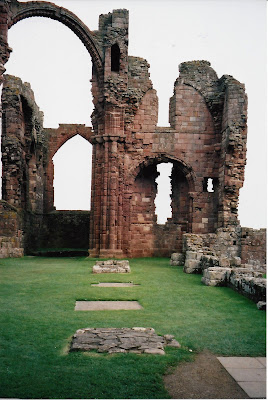"The visitor goes through the place; the place goes through the pilgrim."
-Robert Cooper
In 2005 I traveled to England with my mentors, Stan and Denys Knight, and a calligraphy study group. Together we visited sites of great historical significance in the development of calligraphy and manuscripts.
Meandering through small villages, sitting in ancient churches and cathedrals, and standing on the coastline among monastery ruins, I discovered a profound connection to calligraphy through an ancestry of scribes and the words they had written. My journey became a pilgrimage of discovery; hence, the name Pilgrim's Quill Studio was born. Pilgrim, in this sense, defines me as an artist blessed to be journeying through an art form with an ancient lineage.
The Journey
 |
| South Cottage, Ditchling, East Sussex |
This was my home for four days—a cozy B & B owned and operated by a former stage actress. That's "my room" in the right dormer, with a lovely view of the South Downs.
 |
| "Downtown" Ditchling |
Ditchling was home to Edward Johnston, the "father of modern calligraphy", in the early 1900's. The local museum displays some of his work, as well as his writing desk, stained with ink.
 |
| headstone of Edward & Greta Johnston |
I
had to visit the grave site of Edward Johnston (b. 1872, d.1944) and pause for a moment, just to say thank you for his efforts that revived serious studies of calligraphy.
 |
| Durham Cathedral from the River Walk |
|
|
Next, we traveled to Durham Cathedral.
For three days we viewed manuscripts, toured the Cathedral, and gained a time and place context for the Lindisfarne Gospels, the topic of our study in the days ahead. This late 7th century manuscript is said to have been scribed by one individual, in honor of St. Cuthbert who was Prior of the monastery at Holy Island in that century. Durham Cathedral houses the relics of St. Cuthbert to this day.
 |
| Durham Cathedral Triforium |
"Many of the 600,000 visitors each year may not think of themselves as pilgrims, but the regular daily services and prayers of individuals are still, as always, at the heart
of the Cathedral's life, its main purpose."
(Quoted from a sign at the exit of the Durham Cathedral Treasury)
 |
| Priory ruins, Holy Island, northern England |
|
|
|
|
|
|
|
|
|
|
After Durham, we spent four days on Holy Island,
studying the
Half-Uncial script and display capitals of the Lindisfarne Gospels
manuscript.
 |
| Priory ruins, Holy Island |
Feeling the bitter cold that numbed my fingers as I walked through the Priory ruins, I tried to imagine the life of a 7th century scribe living on the cold northern coast—exposed not only to the elements, but the threat of Viking invaders wanting to destroy this way of life.
 |
| The procession of Cuthbert's body; sculpture by Fenwick Lawson |
I returned home from this trip with an even greater sense of my passion
for lettering, but full of questions too—about my place and purpose as a
calligrapher.
From my journal: "Calligraphy is the surface label—there
is so much more, and it is that 'something more' that I am now seeking
and will try to find the answer. Faith, the spirit behind my hand and
the hands of those before me, the history and tradition of this art and
the spirituality behind it, and the strongest, deepest longing within me
to decipher this labyrinth of connections. There is meaning here that
cannot be put into words yet."
 | |
| Cuthbert's Island—solitude and meditation |
Eight years later, I still don't know that I have found a way to fully describe my experience in England, other than through the words of one of my favorite calligraphers, Ewan Clayton:
"I need not worry whether I am an artist or a craftsman.
Nor need I waste time arguing that calligraphy should be taken seriously
because it is an art like dance or music.
It is something in its own right entirely, with an ancient lineage and a deep responsibility."
-from, Calligraphy of the Heart



























